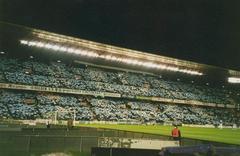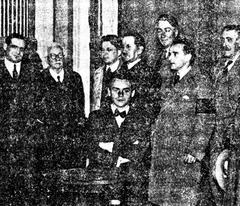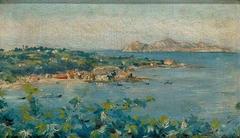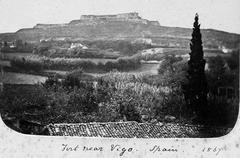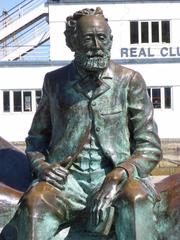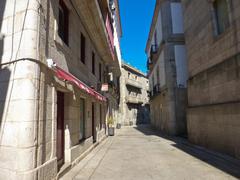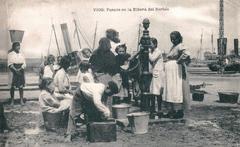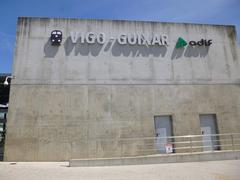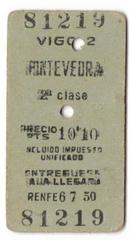
Edificio Bonín Vigo, Spain: Visiting Hours, Tickets, and Historical Sites Guide
Date: 04/07/2025
Introduction
Edificio Bonín is an architectural landmark located at the intersection of Rúa do Areal and Rúa Oporto in Vigo, Spain. Renowned for its eclectic style with modernista influences, the building stands as a testament to the city’s early 20th-century transformation from a modest port town to a cosmopolitan urban center. Commissioned by Manuel Rodríguez Rodríguez, an affluent “indiano” returning from Ecuador, and named in honor of his wife Ángela Bonín Cuadrado, Edificio Bonín encapsulates the ambitions, social mobility, and aesthetic trends that shaped modern Vigo (xalonsof.wordpress.com; Ayuntamiento de Vigo).
This guide explores the building’s historical and architectural significance, provides practical information for visitors, and highlights nearby attractions to help you make the most of your time in Vigo.
Table of Contents
- Historical Background
- Visiting Edificio Bonín
- Architectural Features and Urban Setting
- Legacy, Preservation, and Comparative Significance
- Practical Travel Tips
- Frequently Asked Questions (FAQ)
- References
Historical Background
Urban Context and Origins
Edificio Bonín is located in the historic “barrio dos cataláns,” an area initially settled by Catalan entrepreneurs in the late 18th century for its proximity to the port and favorable business conditions. The district originally featured modest buildings with fish-salting factories below and residences above, reflecting Vigo’s industrial roots (xalonsof.wordpress.com). By the late 19th century, economic growth and social mobility led to a wave of urban expansion and the construction of grander, stone-built residences and commercial buildings along Vigo’s main thoroughfares (Turismo de Vigo).
Commissioning and Patronage
Manuel Rodríguez Rodríguez, enriched by his ventures in Ecuador, commissioned the building in 1909, aiming to create the most sumptuous eclectic residence in the city. The dedication to his wife, Ángela Bonín Cuadrado, is symbolized in the building’s decorative initials “M” and “A”. Its strategic location, adjacent to the mansion of another prominent indiano and facing the Banco de España, expressed both personal prestige and the cosmopolitan aspirations of Vigo’s elite (xalonsof.wordpress.com).
Architectural Design and Influences
Designed by Jenaro de la Fuente Domínguez, a leading architect of the period, Edificio Bonín embodies eclecticism enriched by modernista (Art Nouveau) elements. The building’s chamfered corner, intricate granite façade, and decorative ironwork reflect both the influence of French architectural treatises and the competitive spirit among local architects, especially in response to the nearby Edificio Moderno by Michel Pacewicz (La Voz de Galicia; Treintayseis).
Visiting Edificio Bonín
Location and Accessibility
Edificio Bonín is centrally located at Rúa do Areal, 40, 36201 Vigo, Pontevedra, within easy walking distance from the port, train stations, and Vigo’s main shopping and dining districts. The area is pedestrian-friendly and accessible via public transportation, taxis, or bike rentals (Turismo de Vigo).
Visiting Hours and Tickets
Edificio Bonín is primarily a residential building. While its interior is not generally open to the public, the exterior and its architectural features can be admired at any time from the surrounding streets. There is no admission fee to view the building’s exterior. During special events or heritage days, limited interior access may be available—check the official Vigo tourism website for updates.
Guided Tours and Events
Several local tour operators and the municipal tourism office include Edificio Bonín as a stop on guided architectural walking tours. These tours offer valuable insights into the building’s history, artistic details, and its role in Vigo’s urban evolution. Tours are often available in Spanish, Galician, and English and may require prior booking.
Throughout the year, the area hosts public festivals and cultural events, which provide an excellent opportunity to experience the neighborhood’s vibrant atmosphere (Turismo de Vigo).
Architectural Features and Urban Setting
Façade Composition and Materials
- Chamfered Corner Pavilion: The building’s most striking feature is its rounded corner, crowned by a small tower-like structure and adorned with elaborate stone carving.
- Granite and Ironwork: Constructed from local granite, the façade features wrought iron balconies—a hallmark of the modernista style (La Voz de Galicia).
- Symmetry and Ornamentation: The façade is symmetrically organized with classical columns, semicircular arches, and capitals bearing the intertwined initials of the original owners (Ayuntamiento de Vigo).
Photographic Opportunities
For architecture enthusiasts and photographers, the best vantage point is from the intersection of Rúa Areal and Rúa Oporto, especially in the morning or late afternoon when the lighting accentuates the building’s decorative details. The surrounding urban landscape, with its blend of modernist and eclectic buildings, offers additional photo opportunities.
Symbolism and Artistic Elements
Edificio Bonín is not just a display of architectural exuberance—it also embodies the social ambitions and family legacy of its patrons. The decorative initials, use of local materials, and competitive design reflect both personal and civic pride (Ayuntamiento de Vigo).
Legacy, Preservation, and Comparative Significance
Edificio Bonín stands as one of Vigo’s most important architectural monuments, frequently cited alongside works by Jenaro de la Fuente and Michel Pacewicz as a benchmark of the city’s modernista and eclectic heritage. Its continued use as a residential building and its maintained exterior ensure that it remains an authentic witness to Vigo’s early 20th-century transformation (Treintayseis; LovingVigo).
The building is included in official heritage routes and educational materials, emphasizing its value as both a cultural asset and a living part of the city’s urban fabric (Patrimonio Galego).
Practical Travel Tips
- Combine Your Visit: Include Edificio Bonín in a walking tour of Vigo’s “Golden Mile,” which features other modernist and eclectic landmarks.
- Best Viewing Times: Daytime visits provide optimal lighting for appreciating the granite façades and ornamental details.
- Nearby Attractions: The port, Old Town (Casco Vello), Banco de España building, and Hotel Moderno are within walking distance (FarodeVigo).
- Dining and Shopping: Explore the local markets and seafood restaurants for an authentic Galician experience.
- Accessibility: The building’s exterior is easily accessible; interior access is limited to special events.
- Safety: Vigo is generally safe, but remain attentive to personal belongings, especially during festivals.
Frequently Asked Questions (FAQ)
Q: Can I tour the interior of Edificio Bonín?
A: The interior is private and not generally open to the public, except during special events.
Q: Is there an admission fee to view Edificio Bonín?
A: No, viewing the exterior is free; guided tours may have associated costs.
Q: How do I get to Edificio Bonín?
A: The building is centrally located and accessible by foot, public transport, or taxi.
Q: Are guided tours available in English?
A: Yes, many walking tours offer English-language options.
Q: When is the best time to visit?
A: Daytime, especially during local festivals or architectural tours, offers the fullest experience.
Visuals and Digital Resources
- For images and additional information, visit the Turismo de Vigo official website.
- Download the Vigo tourism app for maps, event listings, and audio guides.
References
- Edificio Bonín in Vigo: History, Visiting Hours, Tickets, and Architectural Significance, 2019, Xalonsof
- Architectural Significance of Edificio Bonín, 2020, Treintayseis
- Edificio Bonín Visiting Hours, Tickets, and Historical Significance, 2021, Ayuntamiento de Vigo
- Vigo Tourism Practical Information, 2024, Turismo de Vigo
- Edificio Bonín and Vigo’s Architectural Heritage, 2021, LovingVigo
- La Voz de Galicia - Modernism Route in Vigo, 2019



